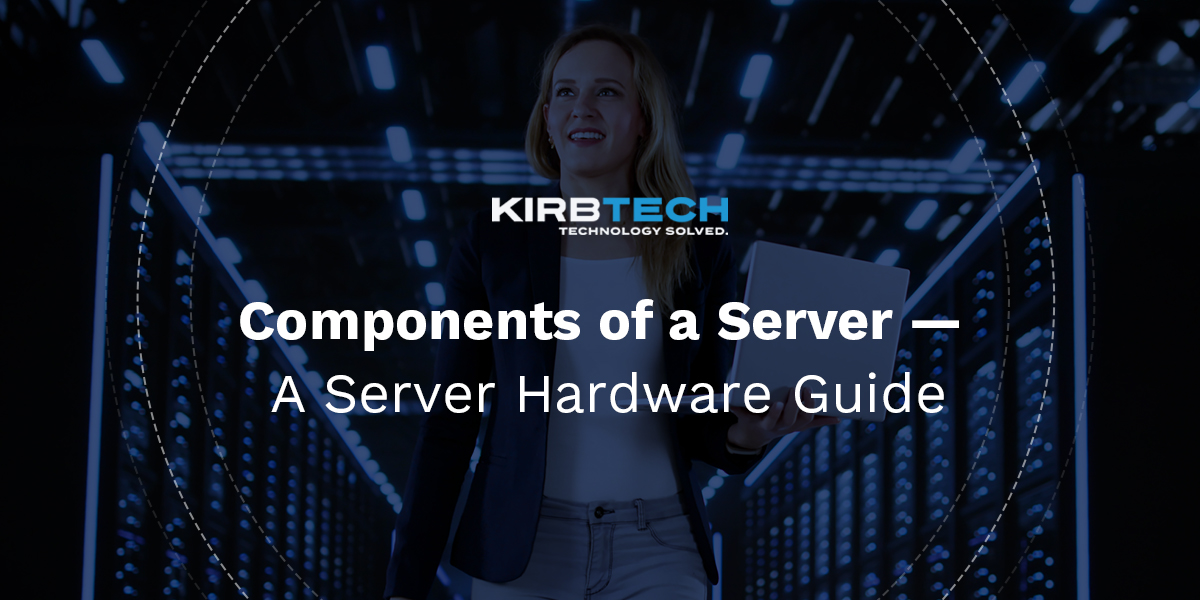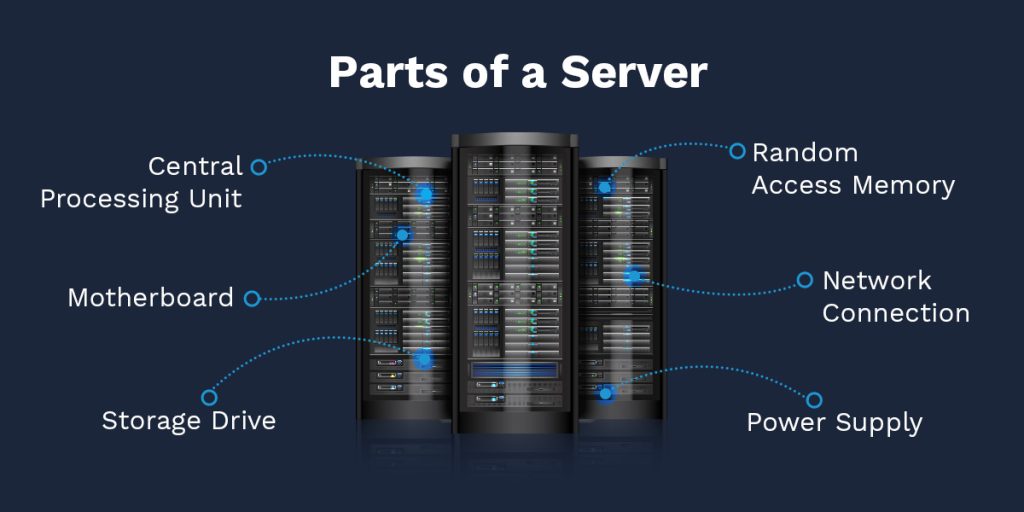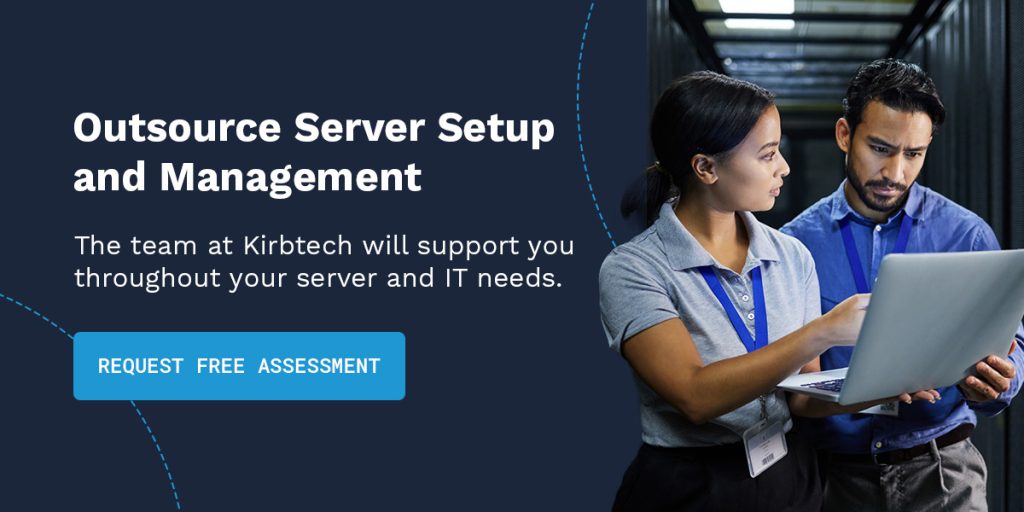Components of a Server — A Server Hardware Guide

A server is a data storage system and a crucial element of any information technology (IT) infrastructure. Businesses of all sizes use servers to store, protect and share data seamlessly across devices on the network. Each server comprises various components that contribute to its functionality.
Kirbtech is an IT company in central Pennsylvania that helps businesses manage their servers. We’re here to help you understand what servers do and the parts that make them work.
What Is a Server?
Modern business relies less on paper and filing cabinets and more on digital data. Still, your company’s data needs somewhere to go. Investing in a server offers much-needed storage space for files and web pages.
Servers can take the form of hardware or cloud-based software that stores data and communicates it to receivers upon request. The receiver — or client — is a device that connects to the server through wired or wireless means. The client requests information from the server, and the server responds accordingly.
There are various server options designed for different purposes. Businesses use servers to manage the resources available to devices on the network. A server can control which devices may access the network, which information those devices can access, how the devices can communicate, and where the devices can relay information. Servers host websites, facilitate email communication, manage print jobs and otherwise hold data until a client needs it.
Types of Servers
A few common types of servers include:
- Web servers: Servers for Internet websites
- Proxy servers: Servers that facilitate communication between a client and a host server
- Virtual machines: Servers that communicate information through software
- File transfer protocol servers: Servers that move files between computers
- Application servers: Servers that connect the client to an application without the client downloading the program
- File servers: Servers that contain files that multiple users can access quickly
- Database servers: Servers that store large amounts of data to process multiple programs
- Mail servers: Servers that allow users to send, receive and store emails
- Domain name system servers: Servers that read domain names to determine a client’s IP address and deliver information accordingly
- Dynamic Host Configuration Protocol (DHCP): DHCP servers assign IP addresses and network configurations to multiple devices on a large network
Parts of a Server
Servers are complex systems that comprise numerous parts. Learn more about the essential hardware components of a server:
1. Central Processing Unit
The CPU is like the brain of the server because it’s the basis of all computer operations and is responsible for executing all commands. While the server memory holds software instructions, the processor processes that data to create results.
As a business, having a powerful CPU means that your server can process information faster and handle many tasks at the same time, boosting your productivity. These efficiencies include loading websites faster, handling many customer transactions at once or creating a smooth app experience.
2. Motherboard
The motherboard is a piece of your server hardware that connects all other parts. It’s the main circuit board in the system that allows communication between the different components and houses the basic input/output system (BIOS) chip, processor and memory slots.
Understanding motherboards is essential because they are the foundation upon which parts of the server are built. They determine the amount of random access memory (RAM) required, the central processing unit (CPU) type and the number of storage drives you can connect.
Small and medium-sized businesses (SMBs) don’t need in-depth knowledge of motherboards and how to choose one for their specific server needs. However, working with a managed IT service provider throughout server installation and maintenance ensures access to proper hardware.
3. Storage Drive
A long-term storage drive is one of the key server hardware components. It’s where all of your business data lives, from website files and databases to emails and operating systems. These storage devices come in two versions:
- Hard disk drives (HDDs) are the traditional drives that contain spinning platters and offer storage through a mechanical process. They tend to be large but offer plenty of storage at a lower investment cost.
- Solid-state drives (SSDs) are a newer drive technology with no moving parts. They use flash memory, are more durable and faster than HDDs, and have a high storage capacity. However, they cost more per gigabyte than HDDs.
4. Random Access Memory
While drives offer permanent storage, RAM is the server’s short-term memory and it stores the information the CPU needs to operate and execute commands. This short-term memory is critical to your server performance. Basically, the more RAM there is, the more your server can handle lots of tasks at once without slowing down.
A reliable server running the latest generation of RAM works wonders for efficiency. It allows applications to run faster, databases to be more responsive and processes to increase without slowing down.
5. Network Connection
Servers need a wired or wireless network connection, which functions as a communication channel, enabling the server to communicate with clients.
The network itself is not a hardware component, but each server has hardware that allows network connection. The connection point on the server is usually on the motherboard. It may be a port for a cable or an input for an adapter that allows wireless network connectivity.
Each device that seeks to access the server’s data must also connect to the network through wired or wireless means. A network can transmit data from the server to the client at speeds of up to a gigabit per second.
6. Power Supply
The final component of a server is its power supply. A power supply converts alternating current (AC) electricity into direct current (DC) electricity before transmitting it to the motherboard. Servers require plenty of power supply due to the amount of information they process and the number of devices they communicate with. The typical server requires a 300-watt power supply or larger.
Ideally, a business should maintain some level of redundancy in its server’s processing power and supply. For example, using more than one power supply with hot-swapping capabilities can help a server stay online even during power interruptions or routine electrical maintenance. Connect each power supply to a separate circuit so the server can continue working in the event of a trip. The use of power redundancy can help businesses that rely on their servers minimize potential downtime.
Outsource Server Setup and Management
Understanding the various components of a server can seem overwhelming at first, but with the right guidance, the basics are easy to understand. Knowing the basics helps SMBs make informed decisions to keep their systems running smoothly.
Still, servers are complex systems that require expertise and diligence to maintain. The team at Kirbtech will support you throughout your server and IT needs. We provide server setup, monitoring and maintenance services for SMBs that need to budget their resources.
We work with businesses across multiple industries in central Pennsylvania, and our team is ready to embrace your needs. Contact us online for more information or to request a free server assessment.



